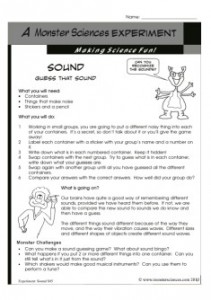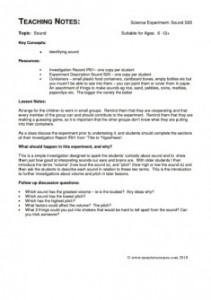A guessing game with sounds – how good are you at remembering sounds?
 |
 |
Monster Sciences Sound Experiment: Guess that sound
What you will need:
- Containers
- Things that make noise
- Stickers and a pencil
What you will do:
- Working in small groups, you are going to put a different noisy thing into each of your containers. It’s a secret, so don’t talk about it or you’ll give the game away!
- Label each container with a sticker with your group’s name and a number on it.
- Write down what is in each numbered container. Keep it hidden!
- Swap containers with the next group. Try to guess what is in each container, write down what your guesses are.
- Swap again with another group until all you have guessed all the different containers.
- Compare your answers with the correct answers. How well did your group do?
What is going on?
Our brains have quite a good way of remembering different sounds, provided we have heard them before. If not, we are able to compare the new sound to sounds we do know and then have a guess.
The different things sound different because of the way they move, and the way their vibration causes waves. Different sizes and different shapes of objects create different sound waves.
Monster Challenges:
- Can you make a sound guessing game? What about sound bingo?
- What happens if you put 2 or more different things into one container. Can you still tell what’s in it just from the sound?
- Which shakers would make good musical instruments? Can you use them to perform a tune?
Teaching Notes: Monster Sciences Experiment: Sound S05
Topic:
Sound
Key Concepts:
Identifying sound
Resources:
- Investigation Record IR01– one copy per student
- Experiment Description Sound S05 – one copy per student
- Containers – small plastic food containers, cardboard boxes, empty bottles etc but you mustn’t be able to see into them – you can paint them or cover them in paper. An assortment of things to make sounds eg rice, sand, pebbles, coins, marbles, paperclips etc. The bigger the variety the better
Lesson Notes:
Arrange for the children to work in small groups. Remind them that they are cooperating and that every member of the group can and should contribute to the experiment. Remind them that they are making a guessing game, so it is important that the other groups don’t know what they are putting into their containers.
As a class discuss the experiment prior to undertaking it, and students should complete the sections of their Investigation Report IR01 from ”Title to “Hypothesis”.
What should happen in this experiment, and why?
This is a simple investigation designed to spark the students’ curiosity about sound and to show them just how good at interpreting sounds our ears and brains are. With older students I then introduce the terms “volume” (how loud the sound is), and “pitch” (how high or low the sound is) and then ask the students to describe each sound in relation to these two terms. This is the introduction to further investigations about volume and pitch in later lessons.
Follow up discussion questions:
- Which sound has the greatest volume – ie is the loudest? Any ideas why?
- Which sound has the lowest pitch?
- Which has the highest pitch?
- What factors could affect the volume? The pitch?
- What 2 things could you put into shakers that would be hard to tell apart from the sound? Can you trick someone?



